We may earn revenue from the products available on this page and participate in affiliate programs. Learn More ›
Among the most iconic American firearms, the Colt 1911 Government model designed by John Browning is at the top of the list. Others include Colt’s Single-Action Army, the Winchester Model 1873, and perhaps the Winchester Model 70—but no one would argue whether the 1911 merits a spot on the podium.
The appeal of the 1911 isn’t fading anytime soon. Despite the dominance of striker-fired polymer-framed pistols in the defensive handgun market, sales of 1911s remain strong. Moreover, gun makers continue to expand into the 1911 world, as Savage has this year, or grow the number and types of 1911s they make.
We just finished our annual tests of new rifles and new handguns at Gunsite Academy in Arizona. Gunsite, as you might know, is a Mecca for the 1911 and those who love to shoot them. It was founded by Jeff Cooper who was a diehard advocate of the single-stack .45 ACP as a defensive fighting tool.
I and my fellow Outdoor Life gunslingers figured what better place to test the field of best 1911s than this hallowed ground. So that’s what we did. Along with staff writer Tyler Freel and OL contributor Sean Murphy, we put nine different 1911s through our test protocol.
Best 1911 Government Models of 2023
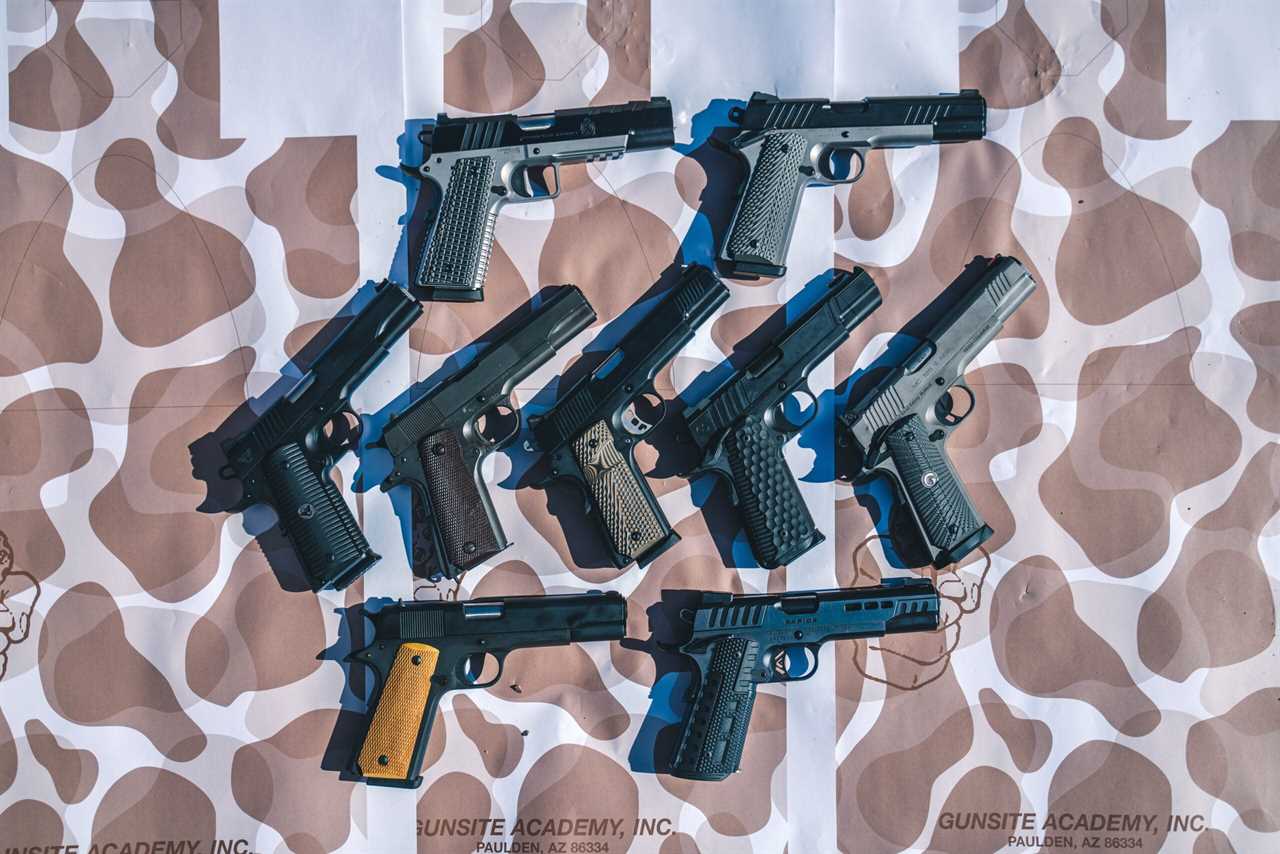
The 1911 test field. Tanner Denton
- Best Overall 1911: Nighthawk Custom Fire Hawk
- Best Semi-Custom 1911: Wilson Combat ACP
- Best Fighting 1911: Gunsite GSP
- Best Value in a 1911: Taylor’s & Co. 1911 A1 Straight Grip
To put a fence around the 1911 category, we kept the field deliberately narrow. We only tested Government-sized 1911s, meaning full framed pistols with 5-inch barrels. In keeping with the OG vibe, we also limited it to single-stack 8-round .45s. Likewise, we eschewed pistols with accessory rails with the exception of the Springfield Emissary.
This let us focus on traditional 1911s and conduct an apples-to-apples analysis. As a useful benchmark we included a Remington Rand 1911 A1 of World War Two vintage that’s owned by Sean Murphy, which he acquired years back through the Civilian Marksmanship Program (CMP).
But even within the tight confines of this project we had quite a variety. The prices ranged from $519 for the Taylor’s & Company Straight Grip 1911 to the princely $4,700 price tag on the Nighthawk Custom Fire Hawk.
With those two pistols bookending the price spectrum, we quickly saw that—for the most part—you get what you pay for. The more expensive pistols had better workmanship, smoother actions, nicer ergonomics and aesthetics, and, in general, better performance and accuracy than their less-costly counterparts.
Why the 1911 Will Never Die
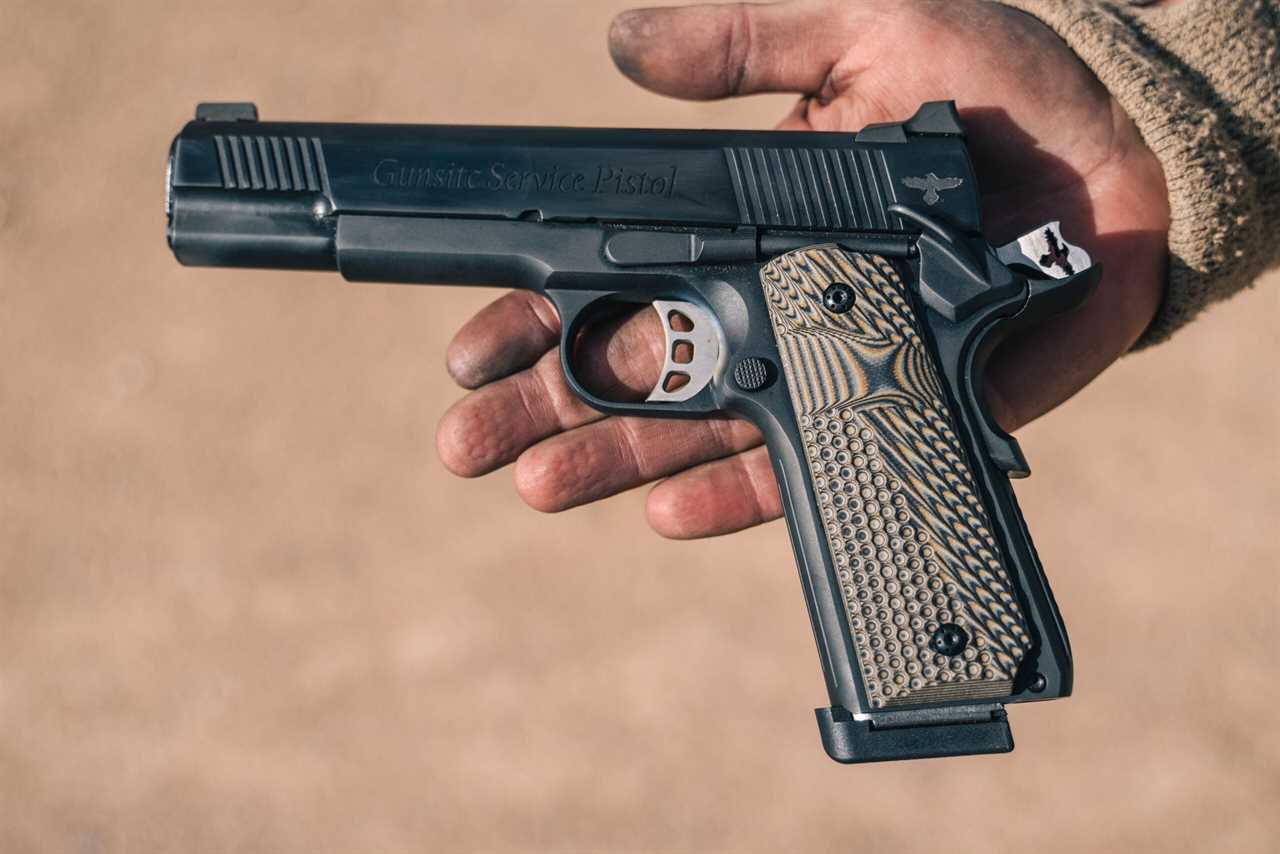
The champ of two world wars isn’t going anywhere.
The 1911 was the standard-issue sidearm of the U.S. military from 1911 to 1985. No other pistol has had an equivalent run.
One would think that the interest in a sidearm would wane once it’s put out to pasture, but part of what makes the 1911 saga so fascinating is how the platform has evolved to stay relevant.
It was as though the 1911 was a phoenix rising from the ashes, emphasizing designs that put a premium on the 1911’s capability as a precision shooting tool, rather than as an everyday working service pistol.
You see that evolution in this field of pistols. At one end is the Remington GI model. It is basic and has a feature set that didn’t deviate one iota from the other 1911s of the time. This allowed for parts to be interchanged easily to keep the pistols in service.
At the other end are high-performance 1911s, like the Nighthawk Custom, Wilson Combat, and Kimber, that share a basic design but incorporate unique elements and features that no longer allow for the easy exchange of parts that defined the earlier generations.
In recent decades demand for 1911s has only increased and gun companies responded with a variety of factory, custom, and semi-custom offerings. After more than 110 years, the timeless 1911 is still going strong.
How We Test
Typically when we conduct our tests, we gather as many new guns in the category as we can and have our panel of judges shoot and grade them. What’s different about this 1911 roundup is that we didn’t limit it to new guns but included some models that have been produced for years.
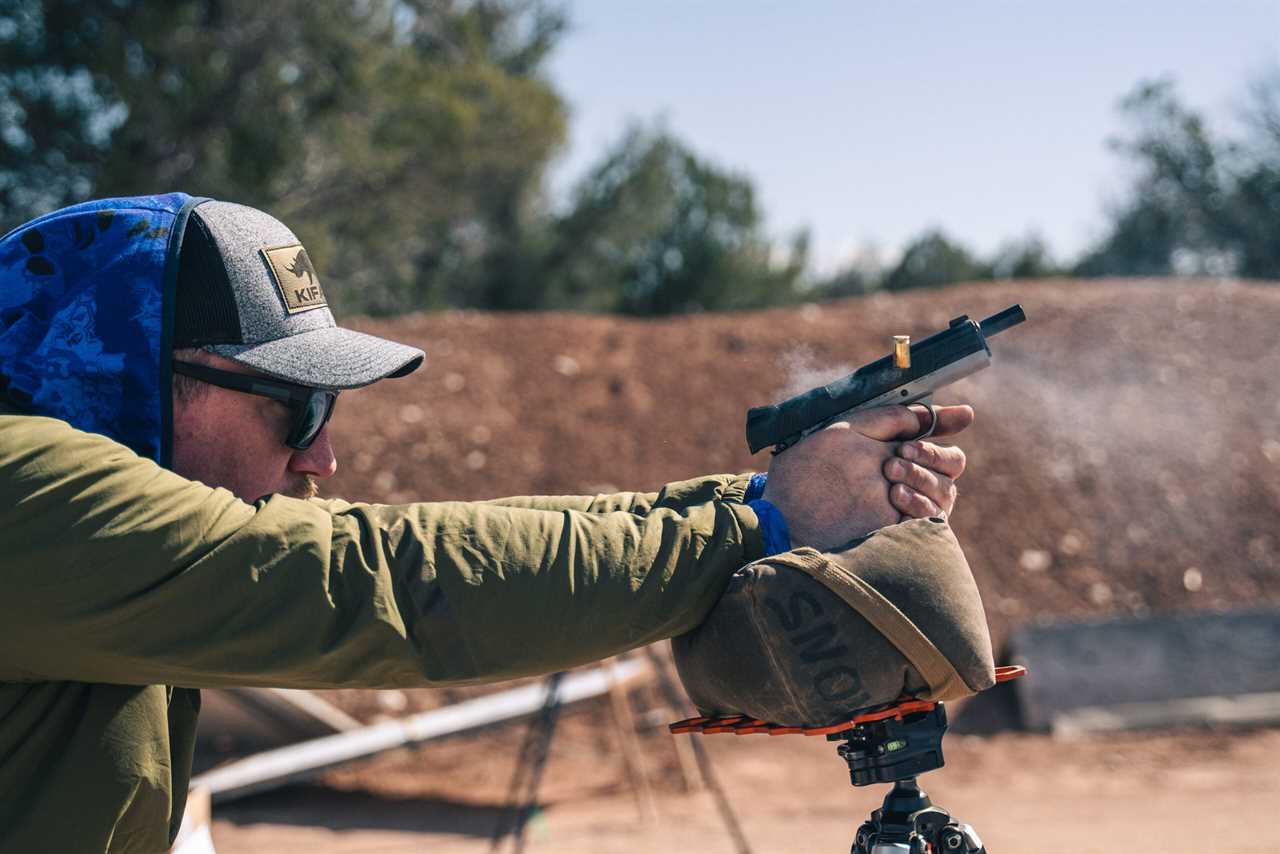
Accuracy testing was done at 15 yards off a bag and tripod.
Other than that small twist, the test protocol is the same. We shot the handguns for accuracy at 15 yards off tripods with sandbag supports. To arrive at the accuracy figures we used the same types of ammo in each gun and took the average of the ten best five-shot groups.
Once that was complete, we switched to practical shooting drills. We shot El Presidente, X drills, and Bill drills. We ran the pistols on spinners, plate racks, poppers, and other steel targets. All told, we put several hundred rounds through each pistol—though some team favorites had round counts approaching 1,000.
We made all that brass fly to get a feel for the workmanship, handling, reliability, and other qualities that we grade the guns on. After analyzing the scores, we figured out which pistols deserved awards for various categories.
How We Grade
Each handgun is evaluated on nine criteria and given a score of 1 to 5 from each judge, except for the accuracy score, which is based on the data from the groups shot. We average the scores for each criteria and use that to determine the ranking and awards. The categories are handling, accuracy, workmanship, aesthetics, ergonomics, meets purpose, versatility, reliability, and value.
The scores then translate to the grades on the report cards for each firearm. Performance consists of the scores from handling, accuracy, ergonomics, and reliability. Design includes workmanship, aesthetics, meeting its purpose, and versatility. Value stands on its own.
To earn an “Excellent” rating, the average of that score must be 4.5 or higher, a difficult mark to hit. “Very Good” is an average score of 3.5 to 4.5; “Good” is from 2.5 to 3.5; “Fair” is from 1.5 to 2.5; and “Poor” is under 1.5.
Best Overall 1911: Nighthawk Custom Fire Hawk
Report Card
- Performance: Excellent
- Design: Excellent
- Value: Good
- Accuracy: 1.33 in. (Average of 10 best five-shot groups at 15 yards)
Nighthawk Custom Fire Hawk Specs
- Action: Single-action semi-auto
- Caliber: .45 ACP
- Capacity: 8+1
- Weight: 2 lb. 9 oz.
- Trigger: 4 lb. 10 oz.
- Barrel: 4.5 in.
- Length: 8.25 in.
- Price: $4,699
Shooters who are into handguns have likely heard of Nighthawk Custom. And if there’s only one thing they know about the company’s pistols it is that they are expensive. The million-dollar question—or with the Fire Hawk, the $4,700 question—is: are they worth it?
We were skeptical at first. That’s an awful lot of cheddar.
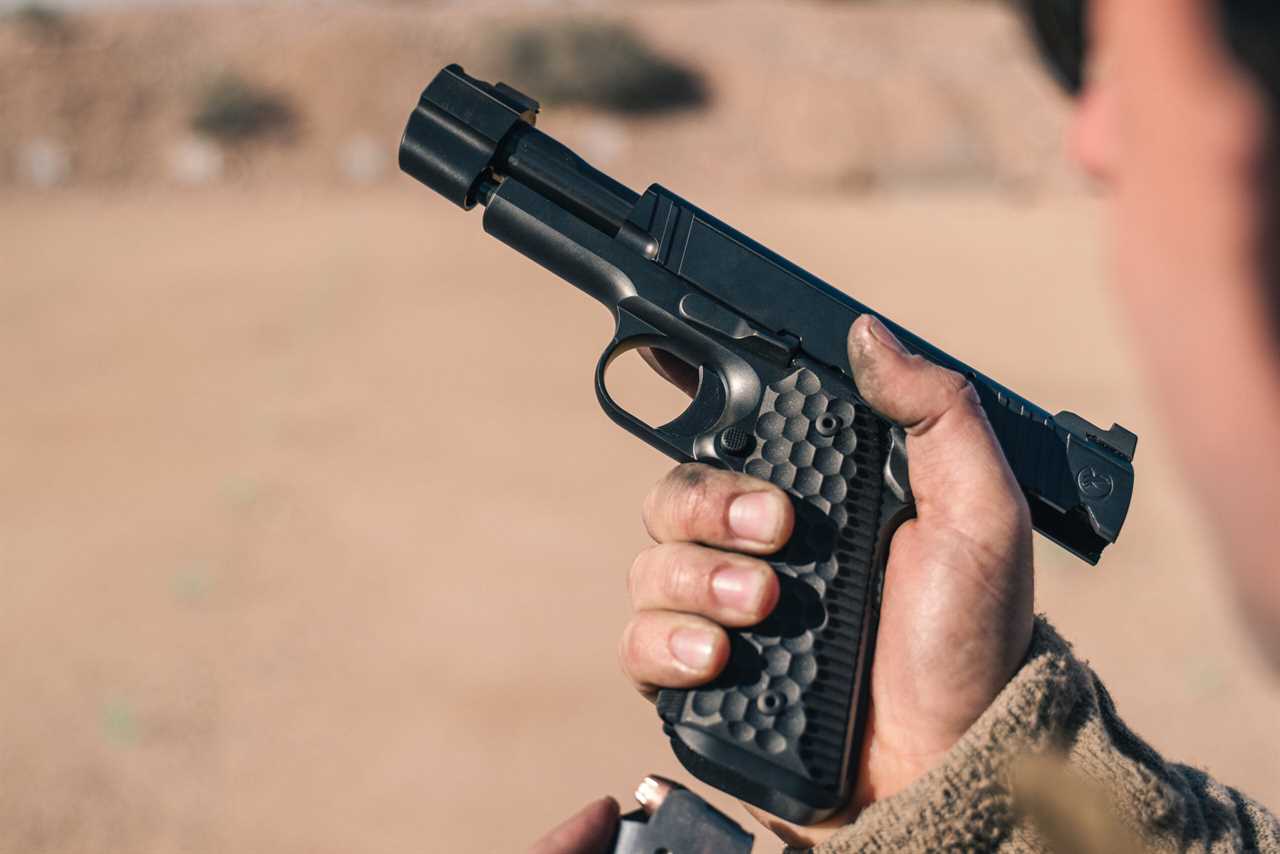
Testers refused to put down the Fire Hawk.
But then we shot it. And shot it some more. And some more after that. In fact, I had a hard time keeping my fellow shooters’ grubby mitts off the Fire Hawk once the test got rolling.
The pistol is superlative. The action is tight and smooth and ran perfectly during our week of trigger pulling. The Fire Hawk is accurate—it turned in one of the field’s best overall accuracy scores—and, thanks to its effective compensator, shoots very flat.
The Fire Hawk easily handled every task we threw at it. El Prez, OL’s charging bear drill, flipping spinners—it didn’t matter. The Nighthawk crushed them all.
It earned “excellent” scores across the board, except for its versatility (very good) and value (good)—and was the highest overall scoring pistol of the test.
“The trigger is a dream.” “It wants to go fast.” “Best-in-class ergonomics.” “Extremely refined.” These were some of the observations my fellow testers jotted down on their evaluation sheets. No wonder I couldn’t pry the pistol from their hands.
Aesthetically the Fire Hawk is blessed with gorgeous, purposeful looks. The aggressive scallops cut into the grips are cool as hell but also surprisingly comfortable and give the shooter fabulous control over the .45.
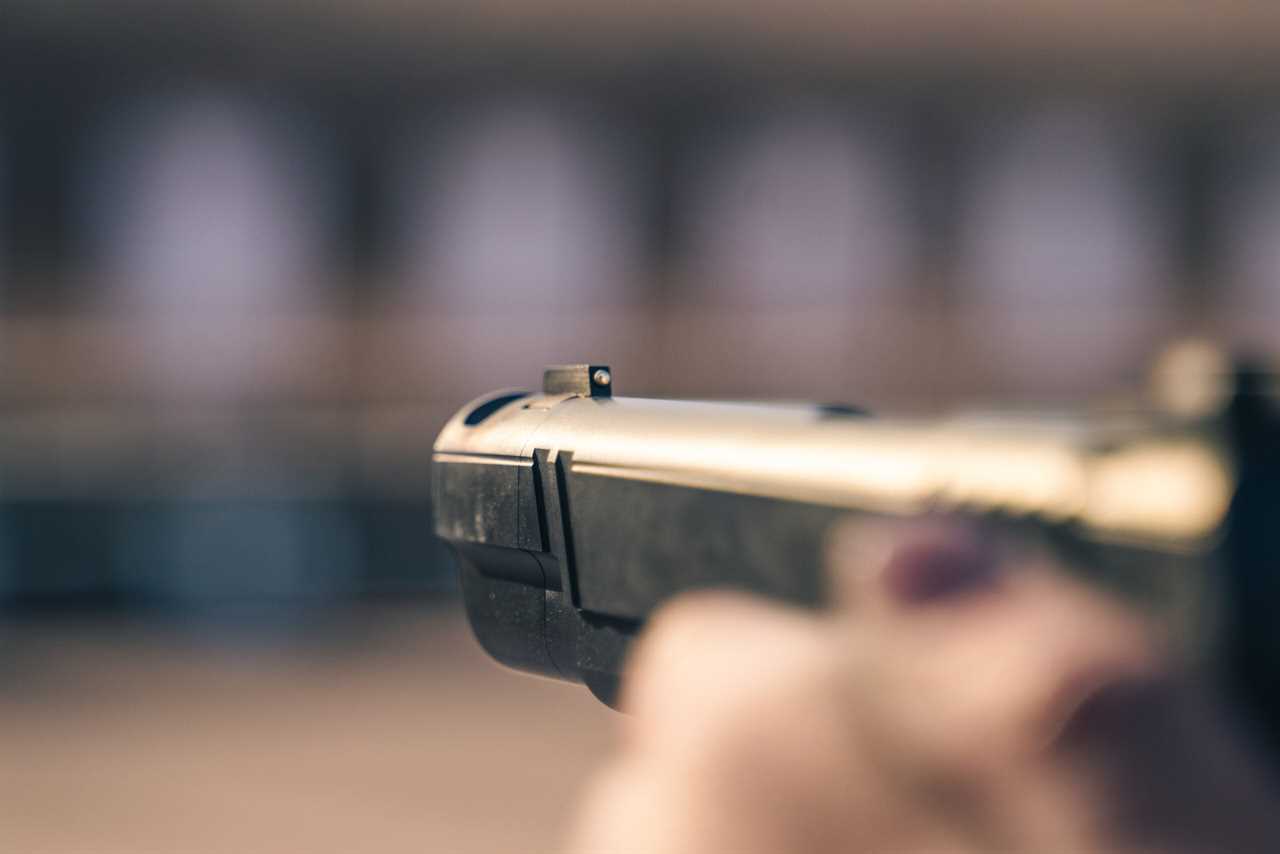
The gold bead front sight on the Nighthawk Fire Hawk.
The Fire Hawk comes with a 14-karat gold bead front sight that grew on us over the test. It feels like it could be a gimmick, but it was quite effective paired with a Heinie Black Slant Pro rear.
Though we shot it only using irons (as we did with all the 1911s), the Fire Hawk has an optics cut in the slide, which is a nice feature that takes a little sting out of the price.
There’s no doubt that the Fire Hawk isn’t for everyone. But there’s also no doubt in our minds that the cost is justified based on what it delivers. It is one of the finest 1911s you can buy.
Best Semi-Custom 1911: Wilson Combat American Combat Pistol (ACP)
Report Card
- Performance: Excellent
- Design: Very Good
- Value: Very Good
- Accuracy: 1.193 in. (Average of 10 best five-shot groups at 15 yards)
Wilson Combat ACP Specs
- Action: Single-action semi-auto
- Caliber: .45 ACP
- Capacity: 8+1
- Weight: 2 lb. 8 oz.
- Trigger: 3 lb. 13 oz.
- Barrel: 5 in.
- Length: 8.5 in.
- Price: $3,285
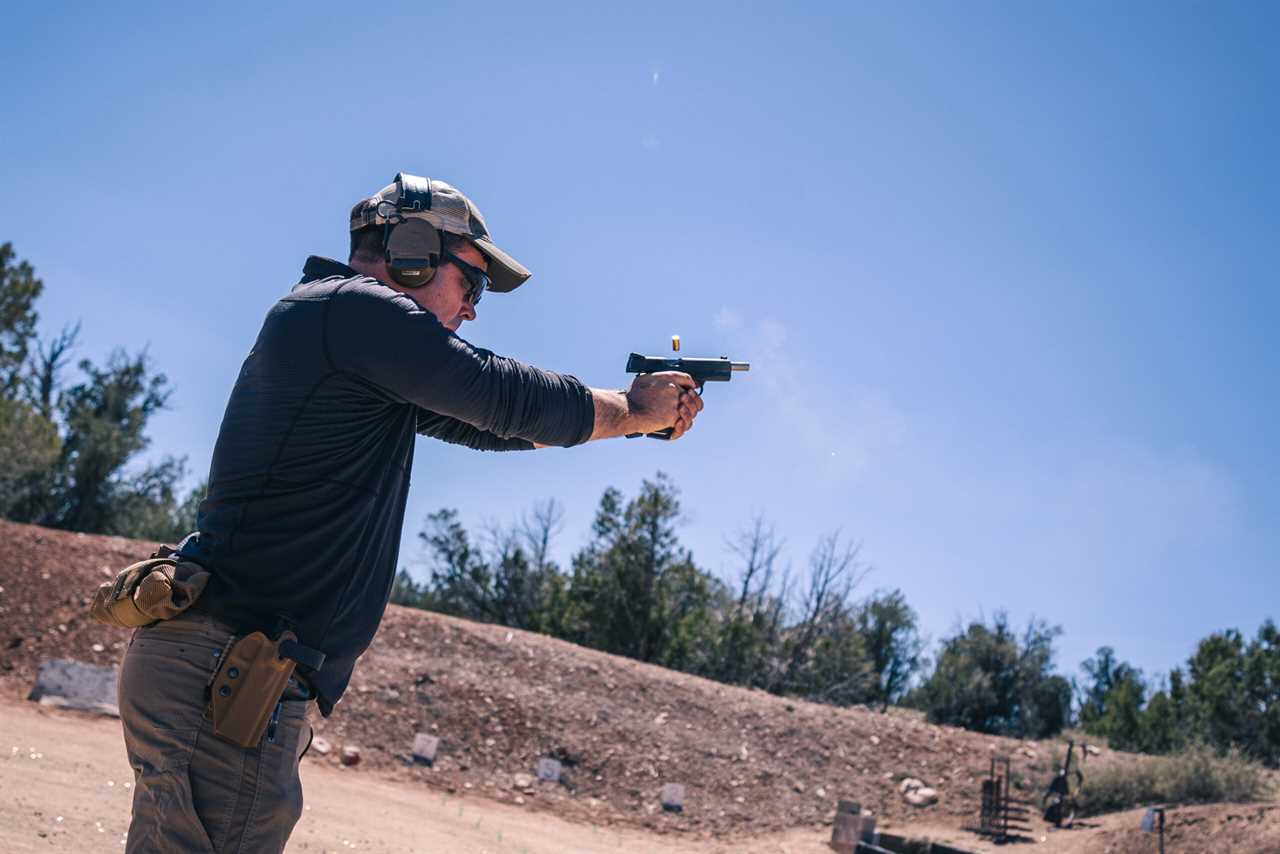
The Wilson Combat is all business.
Wilson Combat is one of the most highly respected names in the 1911 game. Bill Wilson hung out his shingle in 1977 and over the decades has turned the company bearing his name into one of the largest custom and semi-custom firearms makers in the country.
The ACP is one of Wilson’s newer models. To keep the costs down, Wilson limited the menu of options on the ACP, which explains its status as a semi-custom offering. As with the other 1911s in test, we went with a full-sized Government model in .45 ACP, though it can be had in Commander (4.25-inch barrel) and Compact (4-inch barrel) trim, and in 9mm as well.
The ACP was the most accurate 1911 we tested, printing five-shot groups averaging 1.193 inches at 15 yards. The trigger on it is excellent and the sights are top-notch.
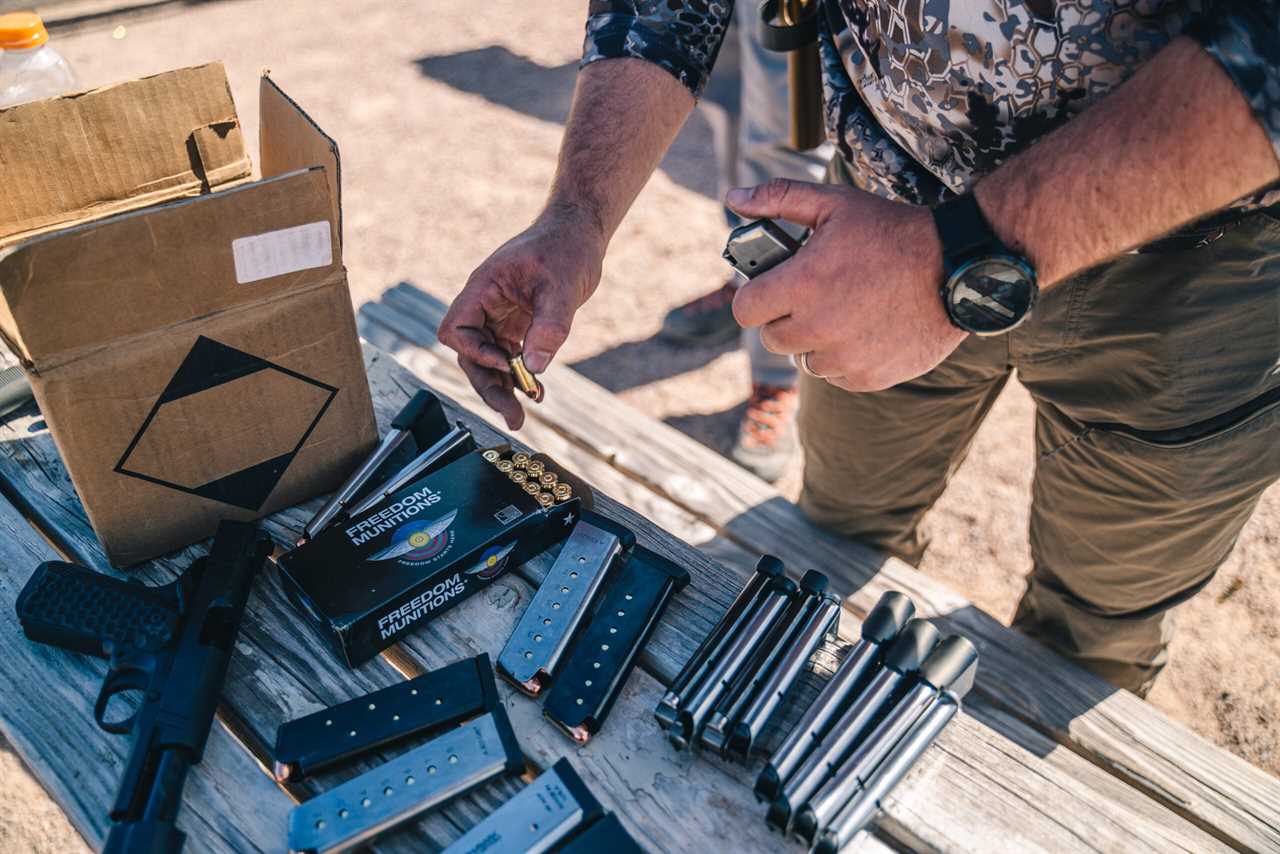
A tester keeps mags loaded with Freedom Munitions .45 ACP.
Wilson refers to the slide’s cocking serrations and the cuts machined into the grips as its “Eagle Claw pattern.” This design is new from the company and lives up to its billing by offering a solid, comfortable grip that isn’t prone to snagging on holsters or clothing.
The all-black finish on the ACP contrasts with the polished stainless barrel and the exposed red fiber-optic front sight. In terms of looks and performance, this pistol is all business.
The ACP digested all types of ammo without any hitches and executed all our drills with speed and assurance.
The only aesthetic critique we had is that for the price the engraving on the slide could be nicer. It seems to be laser cut rather than machined. Front cocking serrations would be a useful feature to have as well, but that is also a matter of personal preference.
These are small gripes for what is in reality a top-notch working gun. If you’re going to carry a 1911 to save your bacon, you could do a lot worse than having a Wilson Combat ACP on your hip.
Best Fighting 1911: Gunsite GSP
Report Card
- Performance: Very Good
- Design: Very Good
- Value: Very Good
- Accuracy: 1.69 in. (Average of 10 best five-shot groups at 15 yards)
Gunsite GSP Specs
- Action: Single-action semi-auto
- Caliber: .45 ACP
- Capacity: 8+1
- Weight: 2 lb. 5 oz.
- Trigger: 3 lb. 12 oz.
- Barrel: 5 in.
- Length: 8.5 in.
- Price: $1,625
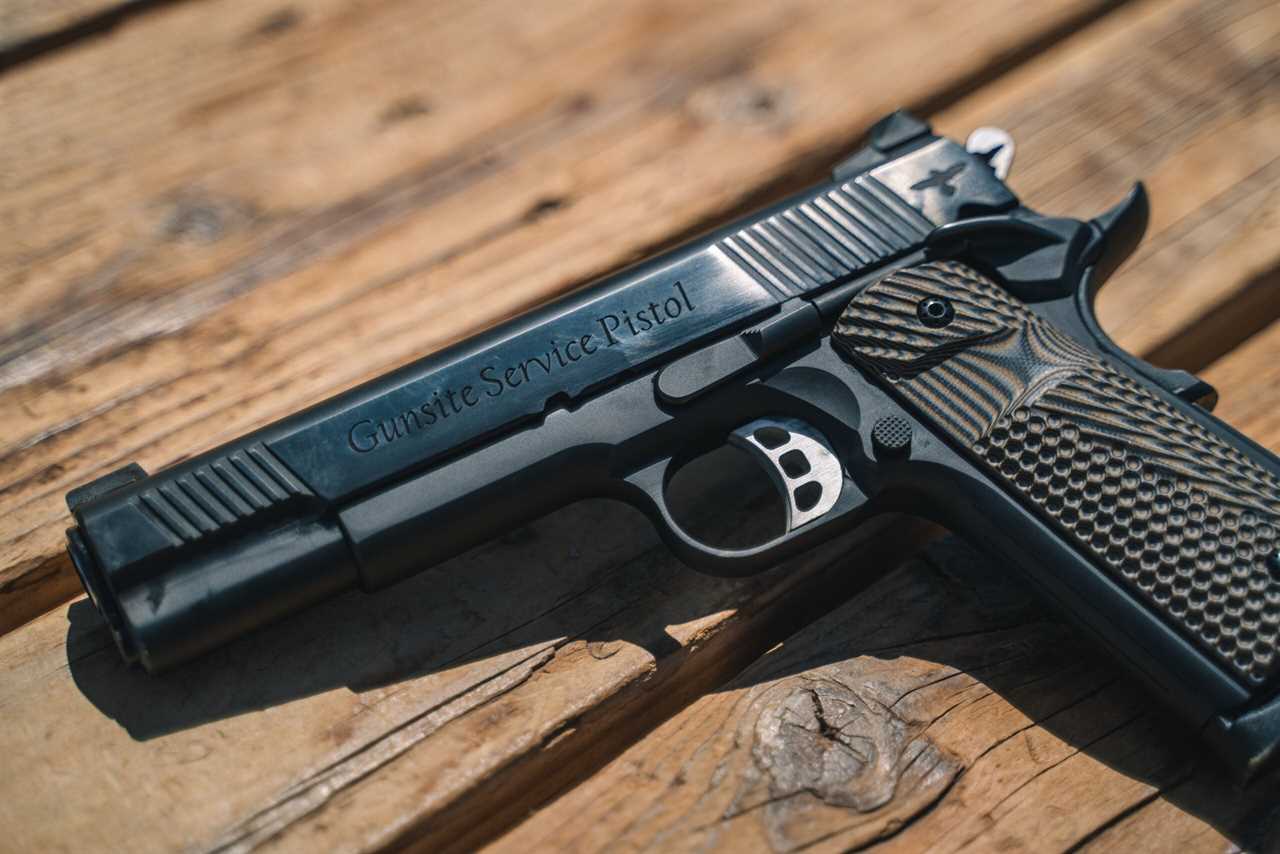
It turns out that Gunsite had a little surprise waiting for the Outdoor Life gun test team this year. After we got settled in, they told us about this new handgun and asked if we wanted to be the first to shoot and test it. There isn’t a timeline in the multiverse where we’d turn down that offer, so after getting the walkthrough of the build I took it right down to the range to put some rounds through it.
I was a little nervous for the Gunsite Gunsmithy, a shop of talented gunsmiths under the direction of Dave Fink. (They’re the crew responsible for building the GSP, which they do by hand.) They had only finalized the design a few days prior, and this was the first prototype.
I needn’t have worried. The Gunsite GSP ran extremely well and impressed all of us. For the price it is a hell of a pistol—and one that Jeff Cooper would have approved of.
There’s nothing extraneous on the GSP. It’s a straightforward fighting gun that embodies the Gunsite training philosophy and ethos. The controls on the pistol are smooth, but tactile, and well laid out. They give the operator positive feedback and are intuitive to use.
The scales on the grip and engraving on the metal are attractive and well executed. And the signature Gunsite raven silhouette cut into the hammer is a cool touch. The pistol isn’t flashy, but details like this elevate it above the crowd.
The parts used in the pistol are high quality, and the fit and finish of the build is very good as well.
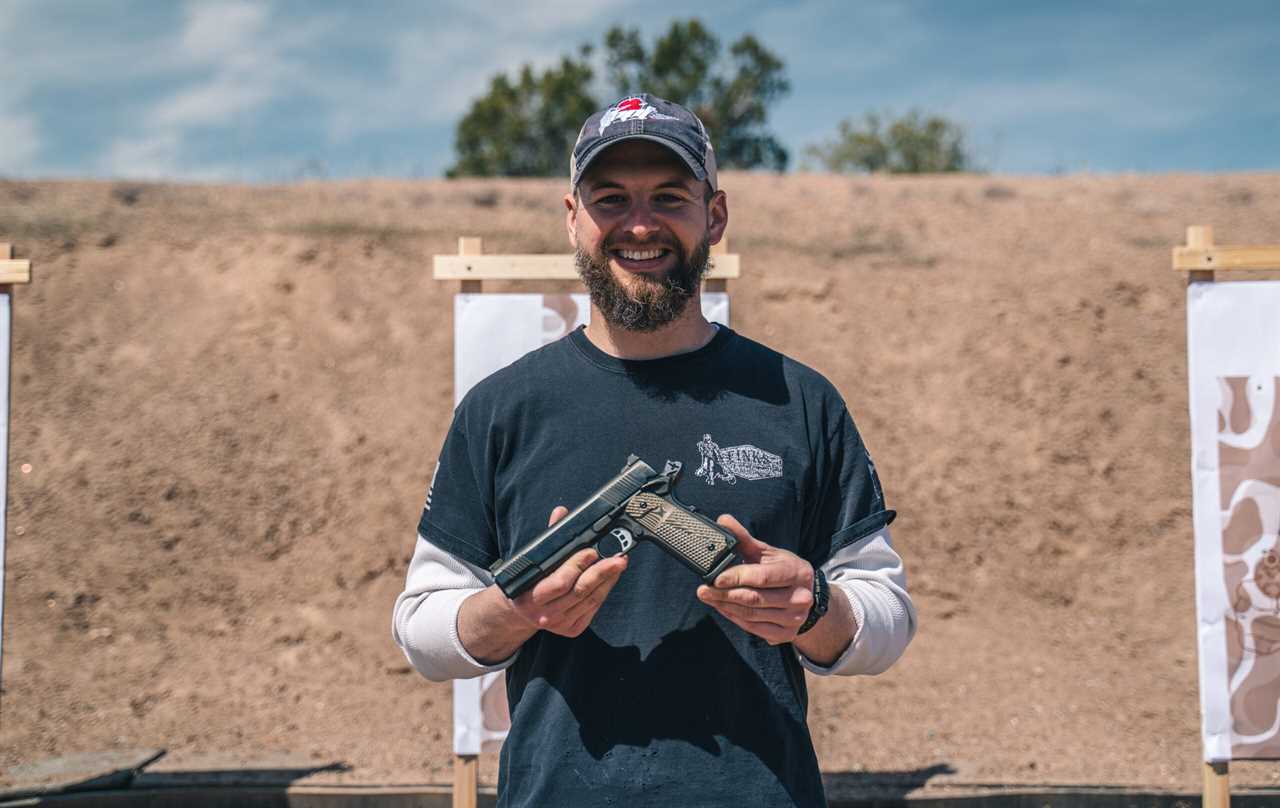
Dave Fink, directror of Gunsite’s “Gunsmithy,” with the Gunsite Service Pistol.
A lot of skilled handwork goes into the GSPs. The Gunsmithy does all the finish work on the pistols. They fit the barrels, execute all the stampings, cut the cocking serrations, bevel the mag well, fix and regulate the sights, and do all the dehorning.
Our sample was a bit picky running JHPs, a common issue with 1911s, but since it was a prototype, I have every confidence that Fink and his crew will overcome that hiccup.
By the end of the test we were fairly smitten with the GSP. It is the first Gunsite branded pistol to be built on their campus in two decades and is a deal at its asking price. We liked it so much, in fact, that three of us ordered GSPs on the spot, which is as strong an endorsement of a handgun as you’ll find.
Best Value: Taylor’s & Co. 1911 A1 Straight Grip
Report Card
- Performance: Good
- Design: Good
- Value: Excellent
- Accuracy: 2.017 in. (Average of 10 best five-shot groups at 15 yards)
Taylor’s & Co. 1911 A1 Straight Grip Specs
- Action: Single-action semi-auto
- Caliber: .45 ACP
- Capacity: 8+1
- Weight: 2 lb. 6 oz.
- Trigger: 6 lb. 12 oz.
- Barrel: 5 in.
- Length: 8.5 in.
- Price: $519
If you like 1911s, you’d have a hard time resisting the charms of this GI model import. We certainly couldn’t. This sweet little gun doesn’t cost much and offers a lot for the money—especially if you’re interested in owning a faithful M1911 A1 service pistol replica. These 1911s are built in the Philippines and look like something granddad would have carried in the Big One.
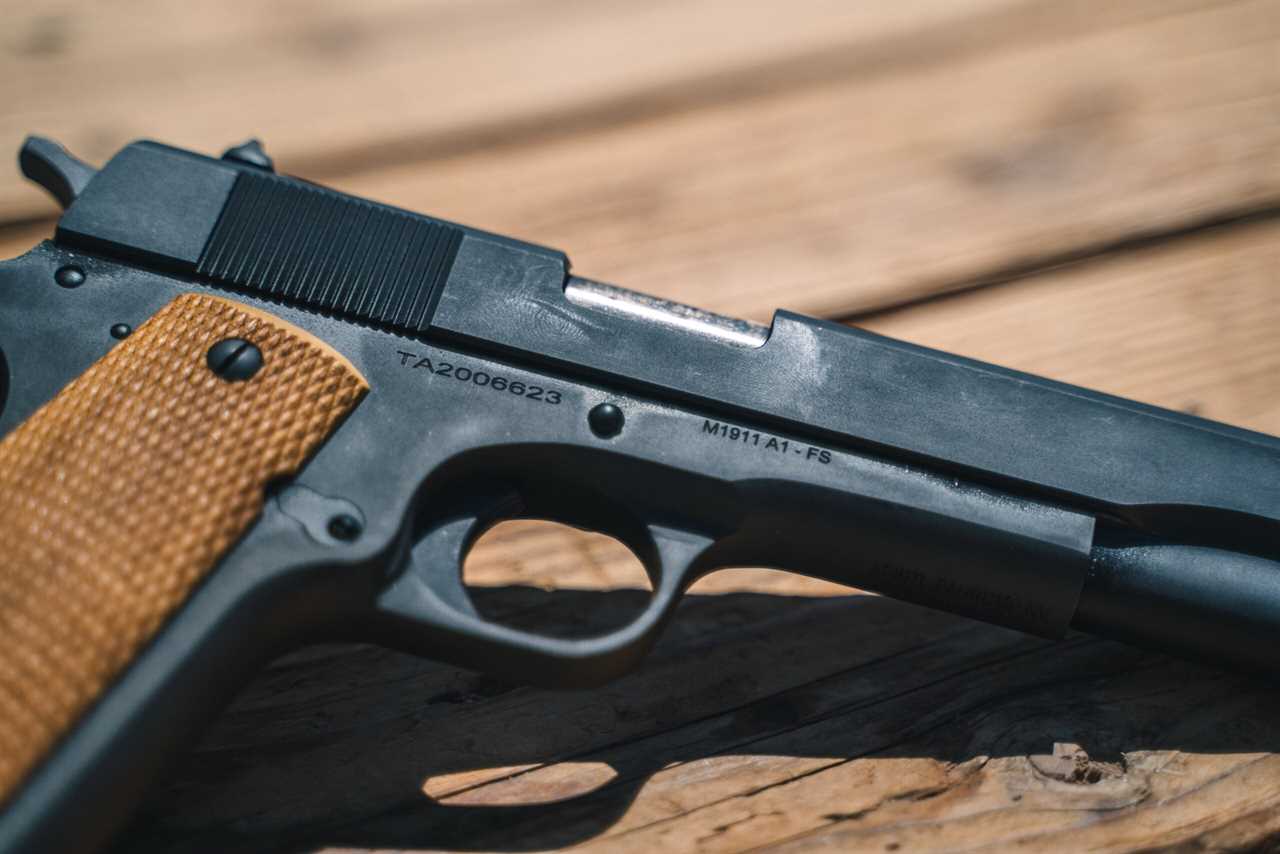
The Taylor is a great value GI 1911.
They come with light colored wood stocks with basic diamond checkering. The magwell is cut as straight as a Marine at attention. The hammer has a thumb spur with a bit of checkering at the tip. The fixed sights are puny. And the thumb safety is small by most of today’s standards and a bit stiff to operate.
Still, we had a lot of fun shooting this pistol and are happy to report that it ran very well—with ball ammo at any rate. Hollow points gave it indigestion, so that cost it some in the reliability category. This didn’t surprise us, however, since 1911s that haven’t been worked over tend to have issues with JHPs.
The accuracy on our sample was decent. With five-shot groups averaging just over two inches it held its own in the field.

The author inspects groups during accuracy testing. Natalie Krebs
Recoil on it was noticeably snappier than with the more refined pistols in the test. The shape of the beavertail is narrow at the tip causing the pistol to bite the web of the hand. It didn’t shoot as flat as others in the test, nor was it as fast thanks to the undersized sights.
That said, we can highly recommend this pistol for shooters on a budget who want a good starter-level GI 1911—either to keep in stock trim or to upgrade over time. For the price, it can’t be beat.
Kimber Rapide Scorpius
Report Card
- Performance: Very Good
- Design: Good
- Value: Good
- Accuracy: 1.514 in. (Average of 10 best five-shot groups at 15 yards)
Kimber Rapide Scorpius Specs
- Action: Single-action semi-auto
- Caliber: .45 ACP
- Capacity: 8+1
- Weight: 2 lb. 8 oz.
- Trigger: 4 lb. 13 oz.
- Barrel: 5 in.
- Length: 8.5 in.
- Price: $1,836
The Kimber Rapide Scorpius doesn’t do subtle. It’s a pistol designed to attract attention. And should the other shooters at your gun club somehow fail to take note, you can simply catch the sun’s reflection on its mirror-bright polished flats on the slide and blind them.
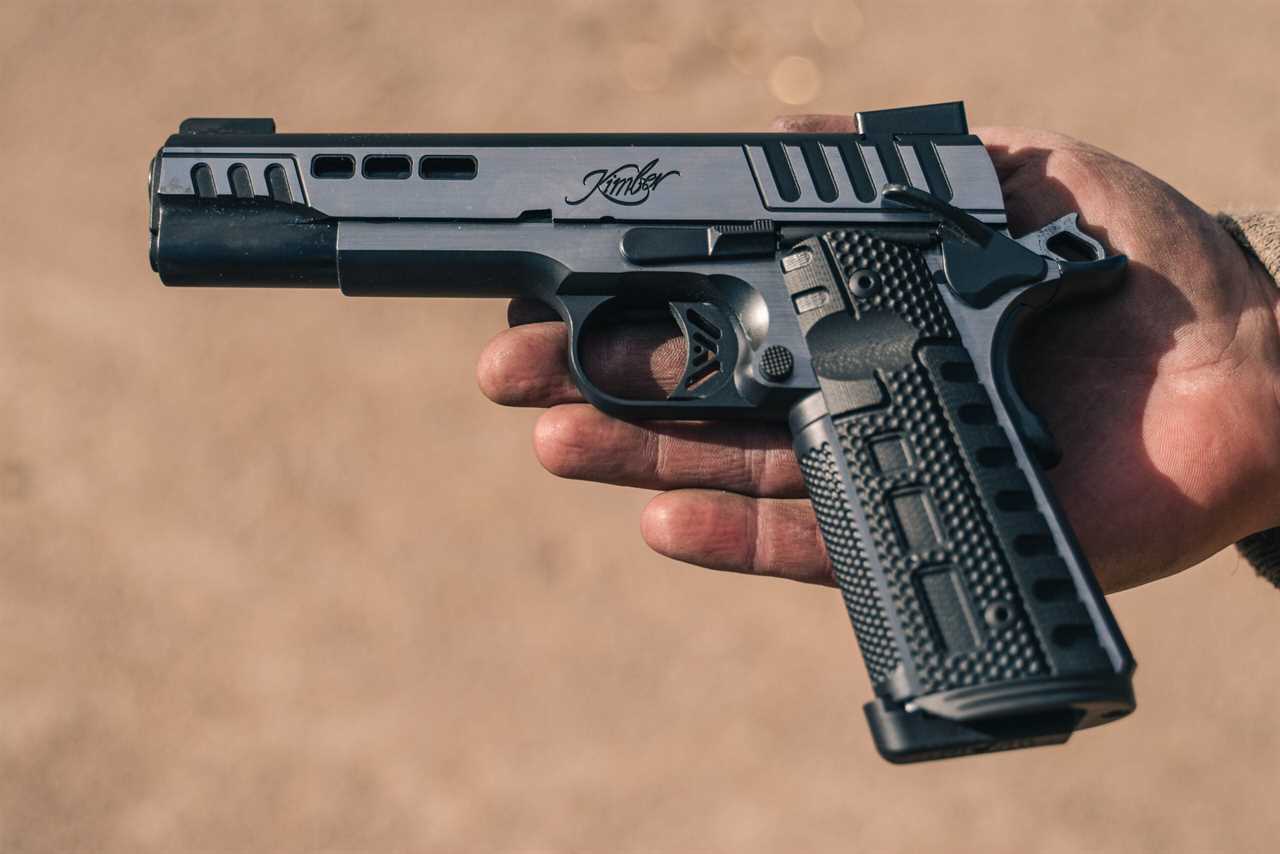
The deep slide cuts on the Kimber Rapide Scorpius. Tanner Denton
The stainless slide has ports cut into the sides and top and deep cocking serrations up front and at the rear. To heighten the visual impact, the cuts and recesses are finished in an attractive matte black coating. This same contrasting aesthetic is worked into the frame and grip as well. While the Rapide Scorpius makes a bold aesthetic statement, it serves up a good portion of steak with all that sizzle. Underneath the bling, it has a lot of fine qualities that make it a solid shooter. We liked the grip texture, the scalloped slide stop, flared magwell, and clean trigger break.
The ambidextrous safety has excellent proportions—it is neither too big nor too small—and we found it effortless to manipulate.
The sights are effective, consisting of a dot inset in a sharp front post and a fixed rear with a U-notch and small dots to either side. The three dots glow green in the dark.
The pistol’s accuracy was very good; it was one of the tighter shooters in the test.
Overall, we had nothing but high praise for the pistol’s ergonomics, handling, and workmanship. It also earned high marks for reliability—we didn’t record a single failure to feed.
Given its flashy looks, it isn’t the best choice for concealed carry. But for a high-quality gun to brag about while shooting with your buddies it is perfect.
Springfield 1911 Emissary
Report Card
- Performance: Very Good
- Design: Good
- Value: Very Good
- Accuracy: 1.306 in. (Average of 10 best five-shot groups at 15 yards)
Springfield 1911 Emissary Specs
- Action: Single-action semi-auto
- Caliber: .45 ACP
- Capacity: 8+1
- Weight: 2 lb. 10 oz.
- Trigger: 5 lb. 9 oz.
- Barrel: 5 in.
- Length: 8.5 in.
- Price: $1,378
The judges on our test team had mixed impressions of the Springfield 1911 Emissary. From the standpoint of accuracy and reliability it was a winner. And we all appreciated how well it handled during our shooting drills.
Its aesthetics, however, struck us as middle of the road. While the sharp checkering pattern on the grip is visually arresting, as is the squared off trigger guard, the pistol has a bit of a brutish look about it that the two-tone finish (a treatment that often imparts a bit of class to a gun) wasn’t able to dispel. “Industrial” is the word one of the judges used. It’s certain to appeal to some shooters, but it didn’t win our hearts.
The checkering was a touch too sharp for us as well. It provided great control of the gun—helping it earn the high scores for handling—but cost it with respect to its ergonomics. None of us found it comfortable after putting a lot of rounds through it.
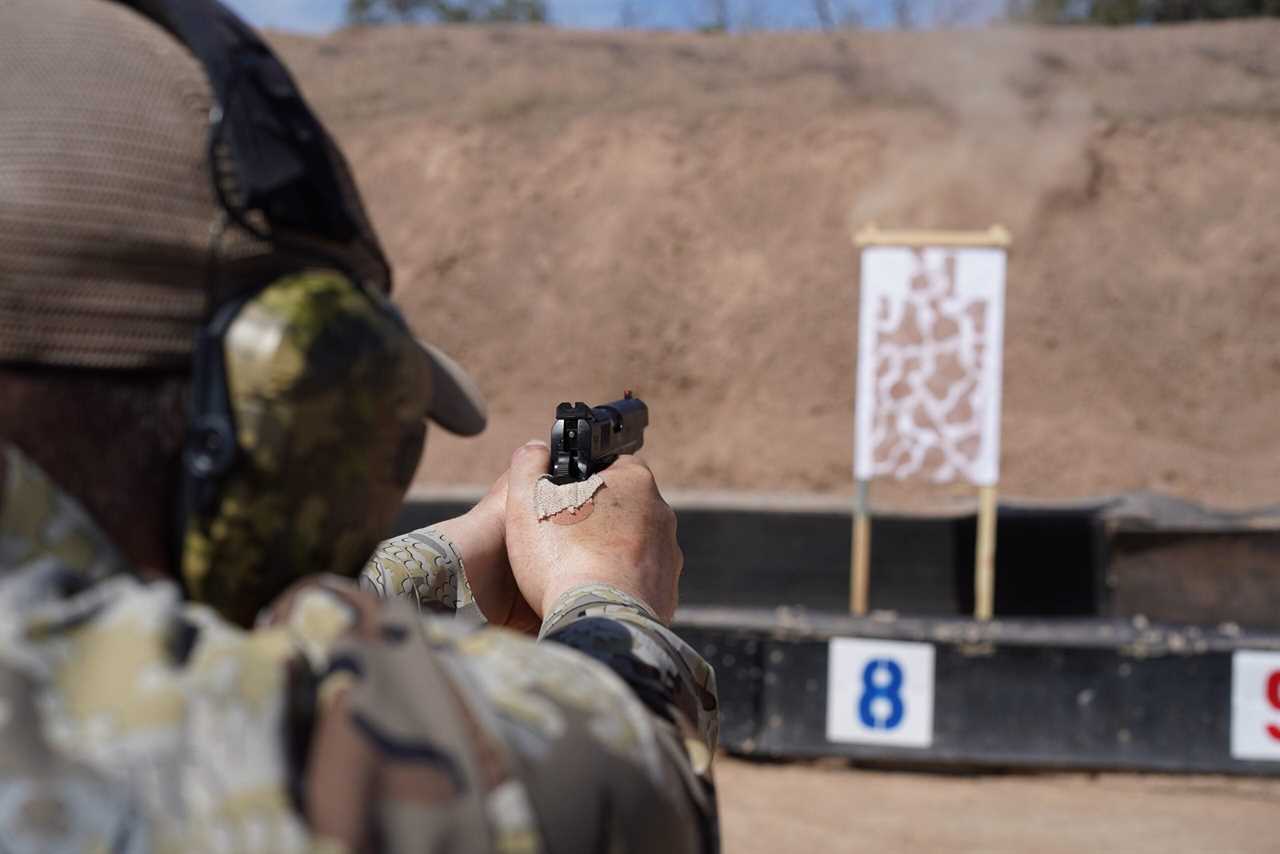
Testers shoots a Bill drill while evaluating a 1911. Scott Einsmann
But the Emissary really shone in accuracy testing. It was among the most accurate guns of the test—both in the field of 1911s and with respect to all the other handguns we shot. It was certainly the most accurate for the price.
The sights on the Emissary are bold and built for quick work at close quarters. The front sight has a large, bright dot rimmed in white with a night-sight insert contained within it. The fixed rear sight has a large U-shaped notch outlined in white as well.
The trigger on it is quite good too. It has positive take-up, a firm back wall, and a crisp break.
Despite our lack of enthusiasm for its looks and ergonomics, we still consider it a very good value.
Remington Rand 1911 A1 GI Model
Report Card
- Performance: Good
- Design: Very Good
- Value: Good
- Accuracy: 2.639 in. (Average of 10 best five-shot groups at 15 yards)
Remington Rand 1911 A1 GI Model Specs
- Action: Single-action semi-auto
- Caliber: .45 ACP
- Capacity: 8+1
- Weight: 2 lb. 7 oz.
- Trigger: 5 lb. 4 oz.
- Barrel: 5 in.
- Length: 8 in.
- Price: n/a
A lot of the guns in this roundup are cool, but only this Remington Rand 1911 A1 is James Dean cool. This is a 1940s vintage 1911 purchased through the Civilian Marksmanship Program (CMP) by test team member Sean Murphy.
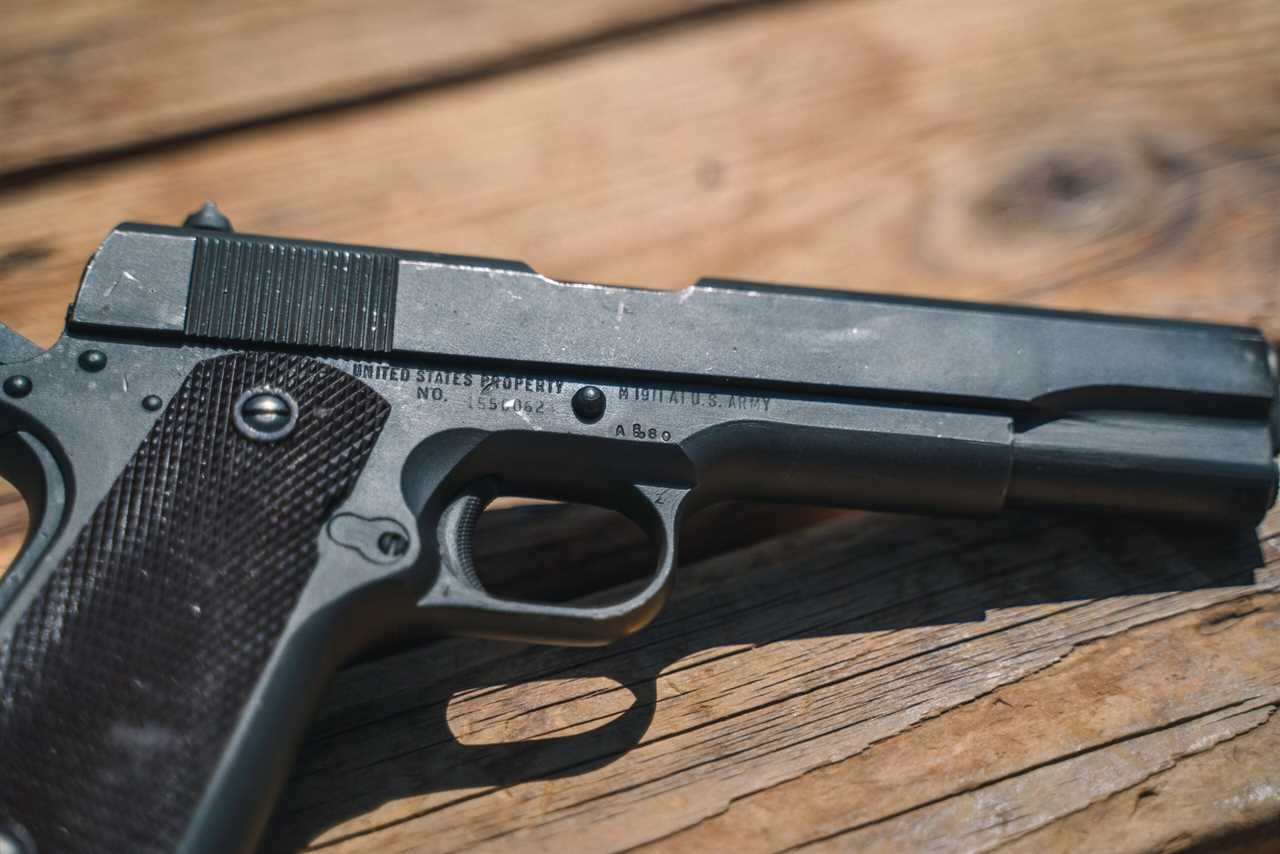
A working piece of history.
Like many service pistols of the World War Two era, it is a mutt, combining a Remington slide and barrel and an Ithaca frame. This was a common practice, and the mix-and-match modularity of the platform was one of the 1911’s virtues as a service pistol.
This specific pistol functioned as God and John Browning intended—digesting 230-grain ball ammo as easily as it did in the Pacific and European theaters. It even ran well with hollow point ammo, especially when we used higher quality magazines from Wilson Combat.
The fit and finish of the pistol are in keeping with others of the same origin and vintage—and it is more accurate than many shooters might give it credit for.
There’s also something extremely gratifying about pulling the trigger on a working piece of history—especially one that can rightfully claim to be a back-to-back World War champ.
Savage 1911 Govt Style Two Tone
Report Card
- Performance: Good
- Design: Good
- Value: Fair
- Accuracy: 1.617 in. (Average of 10 best five-shot groups at 15 yards)
Savage 1911 Govt Style Two Tone Specs
- Action: Single-action semi-auto
- Caliber: .45 ACP
- Capacity: 8+1
- Weight: 2 lb. 8 oz.
- Trigger: 4 lb. 9 oz.
- Barrel: 5 in.
- Length: 8.5 in.
- Price: $1,429
The Savage 1911 Govt Style Two Tone is a newcomer to the 1911 world, having just been introduced this year. The pistol comes in a couple different trims—an all-stainless model as well as in 9mm.
The Govt Style is a solid freshman effort. There’s a lot we liked about the pistol, starting with its accuracy. From supported sandbags at 15 yards, it averaged 1.617-inch five-shot groups, which put it in the upper half of performance in that category.
To shoot well at any significant distance requires good sights, and the Savage comes decked out with a nice set of adjustable Novak Lo-Mount sights with a white dot on the front post.
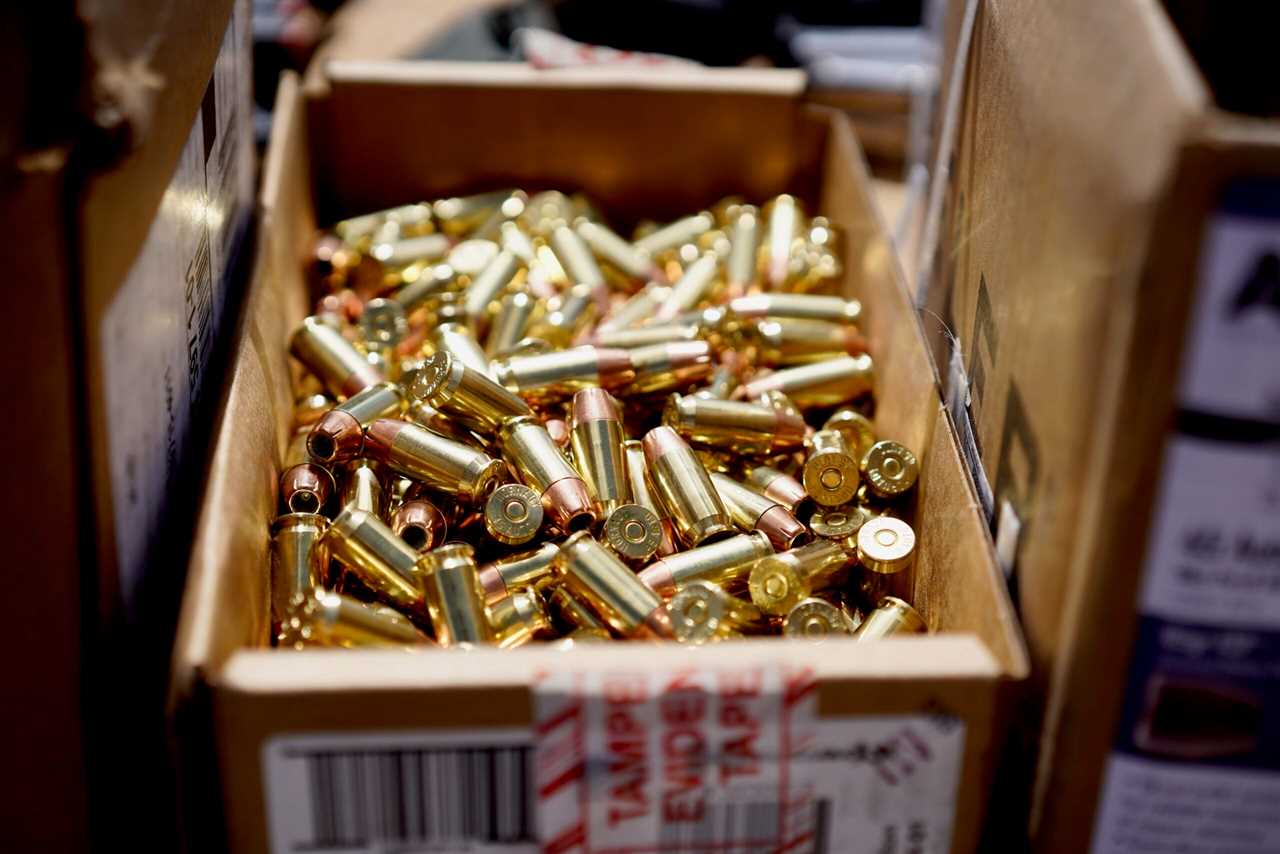
Testers shot thousands of rounds of .45 ACP during testing. Scott Einsmann
The general quality of the build was pretty good, too. The ambidextrous safety was fitted well to the frame and the slide-to-frame fit was tight. Savage did a good job dehorning the 1911, incorporating good chamfers around the ejection port and the muzzle.
The pistol is pretty soft shooting for a .45; it managed recoil well during our dynamic shooting drills.
But there’s room for improvement. We had a number of stoppages with different types of ammo, including ball, that cost it in the “reliability” category. The safety is a bit stiff to manipulate. And the pistol’s aesthetics are average, especially in light of the $1,429 price.
Girsan MC 1911 S Noel
Report Card
- Performance: Fair
- Design: Good
- Value: Fair
- Accuracy: 2.709 in. (Average of 10 best five-shot groups at 15 yards)
Girsan MC 1911 S Noel Specs
- Action: Single-action semi-auto
- Caliber: .45 ACP
- Capacity: 8+1
- Weight: 2 lb. 11 oz.
- Trigger: 5 lb. 11 oz.
- Barrel: 5 in.
- Length: 8.75 in.
- Price: $1,023
Before the shooting started, we were rooting for the Girsan MC 1911 S Noel to pull a Rocky Balboa and blast its way to victory as a scrappy, feature-rich, and affordable 1911. Alas, this didn’t come to pass.
The Girsan started fairly strong, but with each passing round the wear and tear accumulated until the Girsan finally put up its gloves and cried “no mas.” It wasn’t up to the punishment that our 1911 test dished out.
Girsans are imported from Turkey by EAA Corp, which has built a business by offering less expensive copycat versions of various guns including Colt’s, Berettas, Browning Hi-Powers, and others.
The MC 1911 S Noel has an impressive spec sheet. It comes with adjustable target sights. Stainless slide and frame. An ambidextrous safety. A flared magwell extension. Raised magazine release. Checkering on the front and back straps. High beavertail on the grip. Forward cocking serrations on the slide.
These are features commonly found on 1911s carrying much higher price tags than the $1,023 that the Girsan lists for.
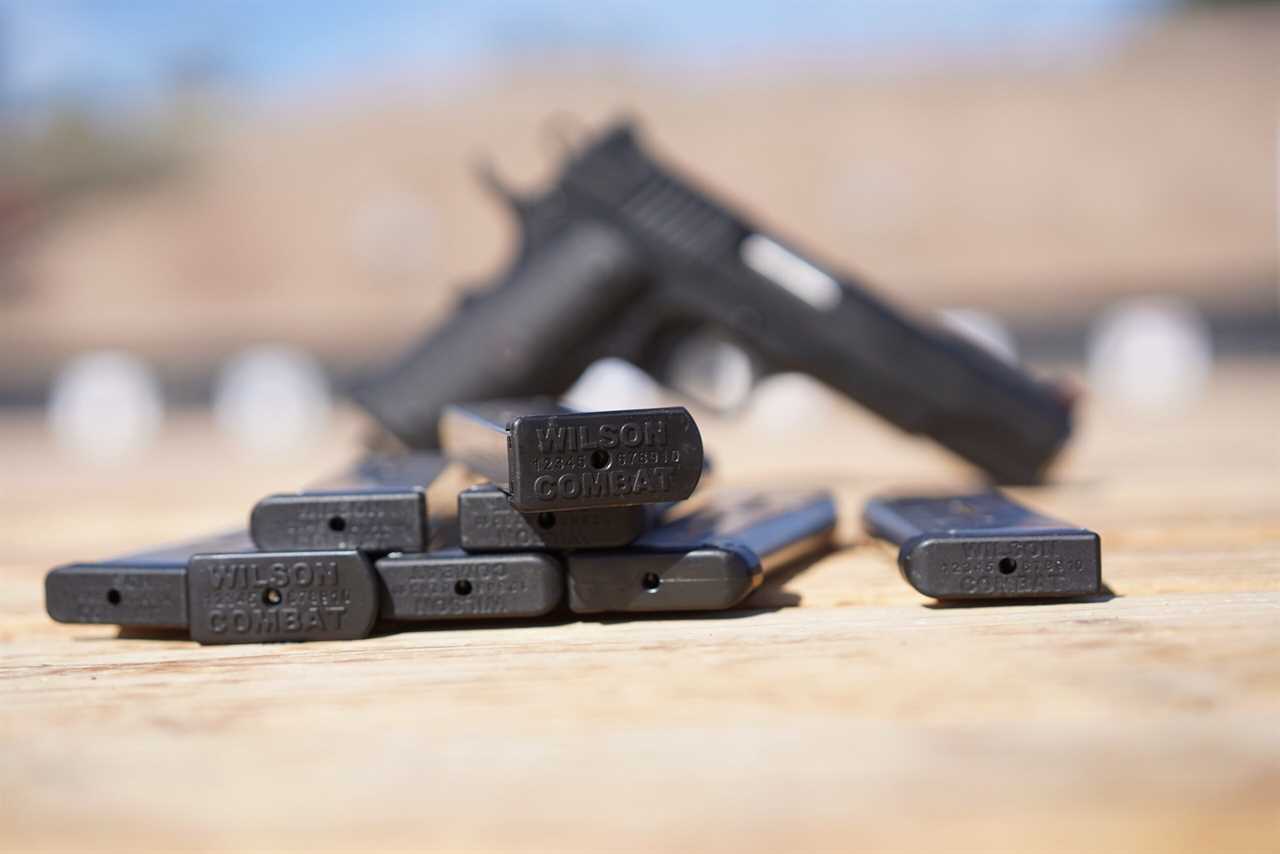
Wilson Combat magazines were used throughout testing the field of 1911s.
Unfortunately, the whole of the gun is less than the sum of its parts. We saw a hint of this with the multiple feeding issues that consistently plagued the pistol. That sinking feeling was confirmed when the rear sight came apart after a couple hundred rounds.
A close look at the pistol shows where the makers cut corners to keep the price down. The pistol isn’t dehorned at all. The finish looks like it was applied by a teenager graffitiing the side of a derelict building. And all the controls have a gritty, stiff feel.
The ultimate problem is that the Girsan is trying to be something it is not—which is a high performance 1911.
We’d love to see what they might accomplish with a pistol in keeping with their abilities, along the lines of the Taylor’s & Co. 1911. But as it stands, we can’t recommend this gun to anyone, especially a shooter who needs to make sure every hard-earned dollar is wisely spent.
Final Thoughts on the Best 1911s

The 1911 will never die.
This is just the first chapter in what will be an ongoing project to test a broader range of 1911s. There are many Government models we plan to add to the list. For example, neither Colt nor Ruger could get us guns in time, and both belong in this field.
And then there are all the other configurations of 1911s: commander models, competition guns, compact 1911s, and 1911s chambered in 9mm, .38 Super, and other rounds.
We will chip away at those categories as time allows. But the center-of-mass 1911—the classic 5-inch government—is well represented in this test and was the perfect place to start.
About Gunsite
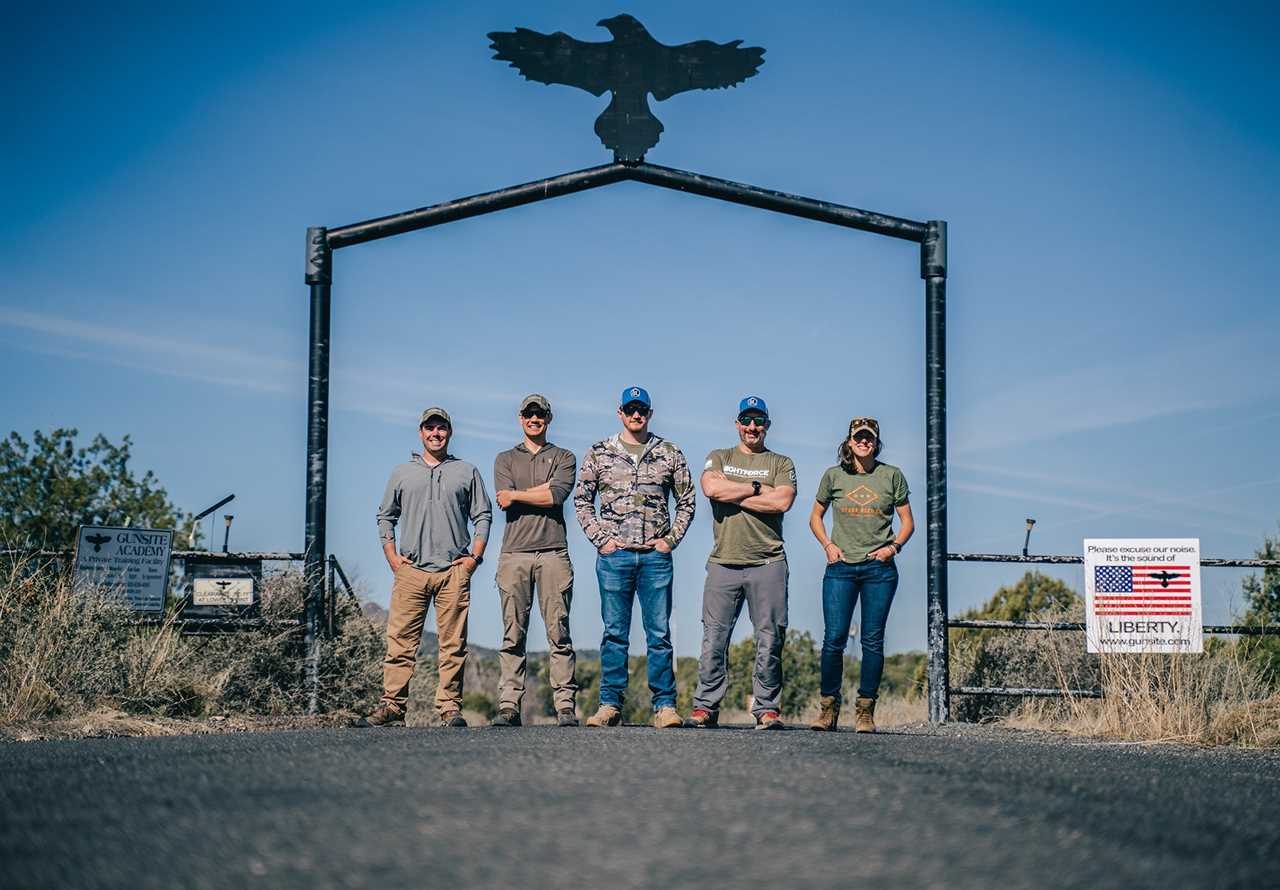
The OL test team at Gunsite Academy. Tanner Denton
This test of the best 1911s was graciously hosted by Gunsite Academy in Paulden, Arizona. As the home of the legendary Jeff Cooper and one of the first firearm training facilities that offered classes to the general public, Gunsite became one of the premier gun training destinations in the country.
Cooper is also the Godfather of the modern 1911 and its employment as a defensive tool. The techniques and drills he developed are still taught by Gunsite’s cadre of excellent instructors.
Every shooter owes it to themself to take a Gunsite class at some point—and there’s no better way to do that than to sign up for the 250 class with a 1911 on your belt.
The post The Best 1911 Handguns: Tested and Reviewed appeared first on Outdoor Life.
Articles may contain affiliate links which enable us to share in the revenue of any purchases made.
By: John B. Snow
Title: The Best 1911 Handguns: Tested and Reviewed
Sourced From: www.outdoorlife.com/guns/best-1911/
Published Date: Tue, 09 May 2023 23:14:48 +0000
----------------------------------------------
 Backyard GrillingWeekend WarriorsAdvice from DadBeard GroomingTV Shows for Guys4x4 Off-Road CarsMens FashionSports NewsAncient Archeology World NewsPrivacy PolicyTerms And Conditions
Backyard GrillingWeekend WarriorsAdvice from DadBeard GroomingTV Shows for Guys4x4 Off-Road CarsMens FashionSports NewsAncient Archeology World NewsPrivacy PolicyTerms And Conditions
